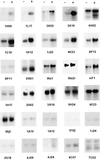Transcriptional responses in the hemiparasitic plant Triphysaria versicolor to host plant signals
- PMID: 11553755
- PMCID: PMC117983
- DOI: 10.1104/pp.127.1.272
Transcriptional responses in the hemiparasitic plant Triphysaria versicolor to host plant signals
Abstract
Parasitic plants in the Scrophulariaceae use chemicals released by host plant roots to signal developmental processes critical for heterotrophy. Haustoria, parasitic plant structures that attach to and invade host roots, develop on roots of the hemiparasitic plant Triphysaria versicolor within a few hours of exposure to either maize (Zea mays) root exudate or purified haustoria-inducing factors. We prepared a normalized, subtractive cDNA library enriched for transcripts differentially abundant in T. versicolor root tips treated with the allelopathic quinone 2,6-dimethoxybenzoquinone (DMBQ). Northern analyses estimated that about 10% of the cDNAs represent transcripts strongly up-regulated in roots exposed to DMBQ. Northern and reverse northern analyses demonstrated that most DMBQ-responsive messages were similarly up-regulated in T. versicolor roots exposed to maize root exudates. From the cDNA sequences we assembled a unigene set of 137 distinct transcripts and assigned functions by homology comparisons. Many of the proteins encoded by the transcripts are predicted to function in quinone detoxification, whereas others are more likely associated with haustorium development. The identification of genes transcriptionally regulated by haustorium-inducing factors provides a framework for dissecting genetic pathways recruited by parasitic plants during the transition to heterotrophic growth.
Figures





Similar articles
-
Differential RNA expression of alpha-expansin gene family members in the parasitic angiosperm Triphysaria versicolor (Scrophulariaceae).Gene. 2001 Mar 21;266(1-2):85-93. doi: 10.1016/s0378-1119(01)00376-6. Gene. 2001. PMID: 11290422
-
Host-root exudates increase gene expression of asparagine synthetase in the roots of a hemiparasitic plant Triphysaria versicolor (Scrophulariaceae).Gene. 1998 Nov 19;222(2):155-62. doi: 10.1016/s0378-1119(98)00502-2. Gene. 1998. PMID: 9831643
-
Heritable variation in quinone-induced haustorium development in the parasitic plant Triphysaria.Plant Physiol. 2001 Apr;125(4):1870-9. doi: 10.1104/pp.125.4.1870. Plant Physiol. 2001. PMID: 11299366 Free PMC article.
-
Host-plant recognition by parasitic Scrophulariaceae.Curr Opin Plant Biol. 2001 Aug;4(4):359-65. doi: 10.1016/s1369-5266(00)00185-0. Curr Opin Plant Biol. 2001. PMID: 11418347 Review.
-
[Identification of chemical signals and haustorium induced of Thesium chinense].Zhongguo Zhong Yao Za Zhi. 2014 Dec;39(23):4544-7. Zhongguo Zhong Yao Za Zhi. 2014. PMID: 25911798 Review. Chinese.
Cited by
-
Phenolic signals for prehaustorium formation in Striga hermonthica.Front Plant Sci. 2022 Dec 6;13:1077996. doi: 10.3389/fpls.2022.1077996. eCollection 2022. Front Plant Sci. 2022. PMID: 36561443 Free PMC article.
-
Using biotechnological approaches to develop crop resistance to root parasitic weeds.Planta. 2021 Apr 12;253(5):97. doi: 10.1007/s00425-021-03616-1. Planta. 2021. PMID: 33844068 Review.
-
The TvPirin gene is necessary for haustorium development in the parasitic plant Triphysaria versicolor.Plant Physiol. 2012 Feb;158(2):1046-53. doi: 10.1104/pp.111.186858. Epub 2011 Nov 29. Plant Physiol. 2012. PMID: 22128136 Free PMC article.
-
Defence transcriptome profiling of Zingiber zerumbet (L.) Smith by mRNA differential display.J Biosci. 2008 Mar;33(1):81-90. doi: 10.1007/s12038-008-0002-2. J Biosci. 2008. PMID: 18376073
-
Pscroph, a parasitic plant EST database enriched for parasite associated transcripts.BMC Plant Biol. 2005 Nov 16;5:24. doi: 10.1186/1471-2229-5-24. BMC Plant Biol. 2005. PMID: 16288663 Free PMC article.
References
-
- Atsatt PR. Parasitic flowering plants: how did they evolve? Am Nat. 1973;107:502–510.
-
- Atsatt PR, Hearn TF, Nelson RL, Heineman RT. Chemical induction and repression of haustoria in Orthocarpus purpurascens (Scophulariaceae) Ann Bot. 1978;42:1177–1184.
-
- Babiychuk E, Kushnir S, Bellesboix E, Van Montagu M, Inze D. Arabidopsis thaliana NADPH oxidoreductase homologs confer tolerance of yeasts toward the thiol-oxidizing drug diamide. J Biol Chem. 1995;270:26224–26231. - PubMed
-
- Baird WV, Riopel JL. Experimental studies of haustorium initiation and early development in Agalinis purpurea (L.) Raf. (Scrophulariaceae) Am J Bot. 1984;71:803–814.
Publication types
MeSH terms
Substances
LinkOut - more resources
Full Text Sources

